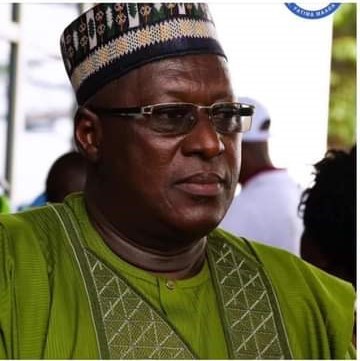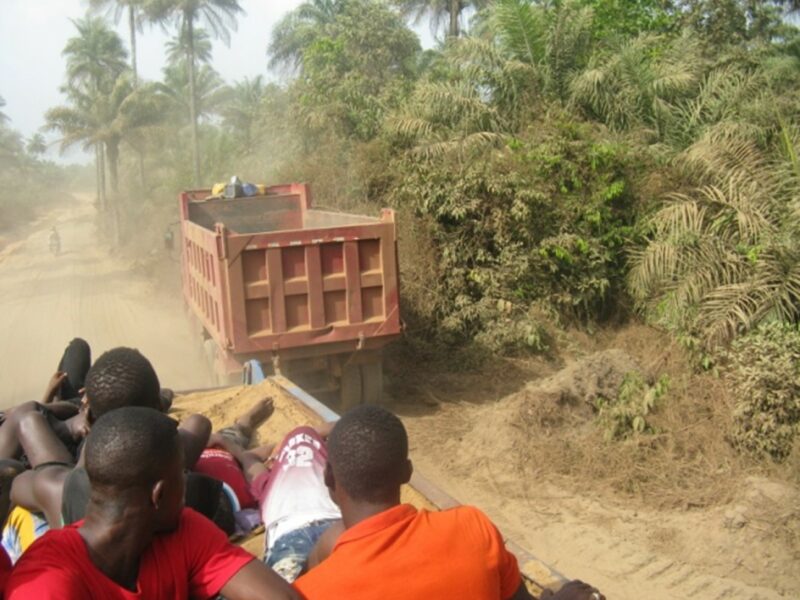Sierra Leone’s infrastructural development in 5 years (1)
I was listening to Star Radio here in China from Sierra Leone and there was this jingle done by the National Commission for Democracy, calling on Sierra Leoneans to be peaceful and tolerant, ahead of the November elections. I can’t agree more with the NCD on this, given our sad history as a post war nation. You see, Sierra Leone is a small country that, the time you go round the twelve districts, you will be surprised to meet several of your relations in all of the said districts which means. We therefore can’t afford to be hate each other. (Photo: John Pa Baimba Sesay, IA, Beijing, China)
The drive that has been embarked upon by the National Commission for Democracy should be strengthened and institutions like Search For Common Ground, Independent Radio Network and other civil society groups should also do what best is known of them, in preaching anti-violence messages. We should do our best to remain peaceful and ensure, the coming elections are peaceful. Only few days ago, the Deputy Minister of Information and Communication, Hon. Sheka Tarawallie, was assuring Sierra Leoneans in the United States of America, of peaceful elections. As he right stated, “The schedule for elections is not in any way tantamount to preparation for war. An election is not a do-or-die affair, wherein the alternative to losing any elections should be violence. The announcement of an election schedule is simply a call on electorates to begin preparing their minds to exercise their franchise…” (Source: http://www.cocorioko.net/?p=35281). This is very true of what elections and politics is all about. And the main political parties, APC, SLPP, PMDC, UDM et el should also be seen taking the lead in preaching messages of peace and tolerance. Let us come together and build on the gains we have kept achieving over the years. The creation of institutions like NRA, Nassit, IMC, NaCSA, among others was an encouraging move by President Kabba(h) but the fact that President Koroma has today been able to make these institutions fully functional, as we see in the NRA, ACC, IMC speaks volume, on the need for us to build on these achievements.
It is with this in mind that I want to bring to our attention our achievements in infrastructure, in the last five years. Granted that President Ernest Bai Koroma has continued to make strides to improve the country in diverse areas like in the fishery sector, the area of human right, in terms of the country’s foreign relations from the perspective of improving the country’s image at the international level and even also the strides in improving the health sector, what we however, cannot dispute, is that, the flagship of President Koroma’s success is mainly tied in the area of infrastructural development. When a nation’s infrastructure is developed, such a nation is bound to growth economically. Development is not a cheap process. This is especially true with infrastructural development. Take for instance, China. This country is today the world’s second largest economy. In 2012 alone, the government’s spending was put at a total of 1.3848 trillion Yuan, “an increase of 19%, in the areas that directly affect people’s lives, namely education, medicine and health care, social security, employment, guaranteeing adequate housing, and culture.” On medical and health care alone, the appropriation was 203.505 billion Yuan which reflects an increase of 16.4% and this figure consists of 8.331 billion Yuan of central government spending and 195.174 billion Yuan in transfer payments to local governments. Education has an appropriation of 378.132 billion Yuan which also reflects an increase of 16.4% (Source for the above figures: Report On The Implementation Of Central And Local Budgets For 2011 And The Draft Central And Local Budget 2012, Delivered At The Fifth Session Of The Eleventh National People’s Congress, By Ministry Of Finance, March 2012). Today, as a result of the economic strengthen of China, the Chinese President recently announced that “China will provide $20 billion credit…to African countries to assist them in developing infrastructure, agriculture, manufacturing and small and medium-sized enterprises…” (President Hu Jintao at the opening of the fifth Ministerial Conference of FOCAC, 2012)
But we have also not been left behind, from the viewpoint of infrastructural development. With a strong desire on the part of President Koroma for Sierra Leone to make use of her resources, we saw, when he came to power in 2007, how he gave great attention to the aspect of infrastructural development. In his speech during the State Opening of Parliament in 2008, President Koroma said, thus: “we are transforming the national transportation network by designing and implementing the largest road construction plan in the history of Sierra Leone…new highways have already been completed between Masiaka and Bo, Bo and Kenema, and Makeni and Matotoka…” (Paragraph 21). In paragraph 24 of the said speech, the President spoke, that “over 780 km of feeder roads all over the country are also being rehabilitated through the Rural and Private Sector Development Project….” and in paragraph 25, he spoke of the construction of 1,305 km of feeder roads in Port Loko, Kambia, Pujehun, Kenema, Bonthe, Kailahun, Kono and Koinadugu through the same fund referred above.
Alimamy P. Koroma, Minister of Works, Housing and Infrastructure, knows of how “Infrastructure plays a crucial role in delivering health and education services, harnessing our potential in agriculture, moving imports and exports – in all our country’s development plans.”- (http://www.european-times.com . Because of this, by 2012, when also addressing Parliament, President Koroma informed of how, “Since we took over in 2007, we have increased spending on infrastructure and other capital projects from under Le180 billion to over Le450 billion on a new development agenda. And realistically, we have seen the impact of these investments. I shall look at the aspect of social Infrastructure, in terms of meeting the basic needs but today, let me attempt to highlight some of the successes scored by Sierra Leone within five years in infrastructure.
Five years back, infrastructure was in a gloomy state, since work on the few roads marked for rehabilitation or social infrastructure projects moved at a very slow pace or had completely stalled as a result of the contracts been badly awarded and executed. When this government did when they came in 2007 was to list infrastructural development as a priority area in the agenda for change. A high level Infrastructure Committee, chaired by the President himself was setup. And so, we have, as a country, being able to achieve thus far:
With just six months in office, President Koroma commenced work on two major trunk roads: the Makeni – Matotoka Highway (35 Km) and the Bo-Kenema Highway (65Km) with joint funding from the World Bank and GoSL. Both were completed in October 2009 and February 2010 respectively. By February 2010, GoSL launched reconstruction work on the Kenema – Pendembu Highway (86Km) with replacement and construction of 8 bridges. Preface work – i.e. resurveying and designing have been completed, with earthworks in progress. Completion date is set at January 2013. The Masiaka – Bo Highway (164 Km), funded by the EU and GoSL has been completed .By December of 2010, reconstruction work commenced on the Lungi – Port Loko Road (62Km) and 30 Km of feeder roads in the Lungi township and work is far ahead. With joint funding from the EU and GoSL, the Freetown-Conakry Highway (86Km), consisting of the Rogbere – Pamlap road (78km), Pamlap – Faremoryah road (8km) was reconstructed with a new common border post between Sierra Leone and Guinea, at Pamlap, with reconstruction work commenced in March 2009 and was completed in December 2011.
Between 2008 and 2011, a total of 1205 Km of feeder roads throughout the country were upgraded. A joint EU and GoSL funding rehabilitated a total of 650Km in Kambia, Kenema, Port Loko and Pujehun districts. In Bombali, Tonkolili, Kailahun and Kono districts, the Islamic Development Bank funded Rural Infrastructure Development project did spot improvement on feeder roads totaling 555 Km. From March of 2010 rehabilitation works commenced on a total of 89Km of some selected major roads in district headquarter towns. In Bo, Kenema, Makeni Magburaka, Port Loko, Kambia and Lunsar, construction is at the 98% completion stage and completion is set against June 2012. In Moyamba, Pujehun, Mattru Jong and Bonthe, and against a deadline of November this year, construction is in progress and this is funded by the government. This is also same with Kono, Kailahun and Kabala.
In the Western Area, again with GoSL funding, government has undertaken rehabilitation work involving the reconstruction of an aggregate length of 26km pavement and drainage structure of streets in the West, Central and East of Freetown. Work on 12 streets (Victoria Street, King Street, Mends Street, Duke Street, Guy Street, Dundas Street, Collegiate Road, Caulker Street, Berwick Street, Aberdeen Ferry Road, Personage Street, and Bryne Lane) have already been completed. Thunder Hill Road, Black Hall Road, George Brook Road, Cape Road, King Tom, among others have also got government attention. Lumley-Tokeh Road (21Km), road has also been put on track. President Koroma was also able to source and increase funding from US $27.75M to US$38M in July 2009 for a four lane road from Lumley Police Station to Hamilton Junction, with four lane provisions to be made on the culverts and bridges up to Tokeh.
Another infrastructural development is the widening of the Lumley-Hill Cot Junction route (3.4Km) into a four lane dual carriageway. Again, Wilkinson Road (5.2Km), has been widened into a four lane dual carriageway up to Lumley Police Station. President Koroma has also undertaken the construction of the Hillside Bye-pass Road, connecting the central and western ends of Freetown. Phase I: Pademba Rd/Jomo Kenyatta Rd-Bambara Spring (1.5Km) started since May 2010.
The airport has also not been left out in this ‘revolutionary’ development moves. By 2007,, our air travelling system was in a bad shape. Our airport was below standard when compared to others even within the sub region. Today the airport has got a face light in terms of rehabilitation. In 2010, w various works were started, including the overlaying of the runway, widening of the taxi way and relocation of ground lighting system. There has been a big step in terms of transformation as the ground lighting system is fully functional now; the water supply is adequate; electricity supply increased to 60% and 70% of the X-ray equipment has been purchased and installed. At the seaport, we have seen an infrastructure concession agreement between GoSL and the French company, Bollore Africa Logistics, which led to the handing over of the container terminal at Queen Elizabeth II Quay to the concessionaire in March 2011.This, is expected to help transform Sierra Leone into a trans-shipment hub on the West African coast. Revenue generation from this venture will grow from an initial amount of US$ 6M followed by an annual rental fee of US$2.1M to US$18.7 million dollars by the year 2020.Rehabilitation of the Kissy oil jetty is in progress.
Part 2 will look at social infrastructure, in terms of meeting basic needs of our people and what President Koroma has achieved in this direction. With these achievements, the question is; can we afford to not vote President Koroma for another term? The decision is yours.
Stay with Sierra Express Media, for your trusted place in news!
© 2012, https:. All rights reserved.





